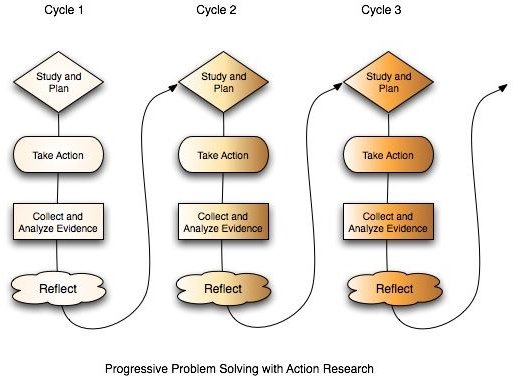Action Research Methodology - Example and Definition
Plan, Act, Observe, and Reflect
[caption id="" align=“aligncenter” width=“600”]
Action research methodology is outcome based in that it aims to improve the methods used in educational, social science, community, and other settings. Also known as participatory research, it calls for insight, reflection, and personal involvement with the topic being explored. It is conducted in real world settings by the people directly involved with the problem or situation being investigated. Most commonly used in the Education field, MAT and M.Ed. candidates will most likely perform these types of research projects during their graduate studies. For the education graduate student, action research is not a bland analysis of data but a deliberate assessment of the impact specific actions have on student achievement. After a problem or subject to examine is recognized, there are four, repeated steps: Plan, Act, Observe, and Reflect (O’Brien, 1998). Changes should be made to the plan, and the steps repeated until the researcher is satisfied he has fully explored the effectiveness of the action(s) taken and adjustments implemented. The observation methods are left to the discretion of the researcher or researchers. Interviews, collection of quantitative data, note-taking, and discussion are all possible observation and reflection techniques.
[caption id="" align=“aligncenter” width=“600”] Action research methodology requires multiple feedback loops[/caption]
Action research methodology requires multiple feedback loops[/caption]
Example - Action Research Methodology
Research Topic: Is independent study a worthwhile activity for students? Does it have a positive impact on student learning and performance? Plan: Compare students’ grades on independent study projects with grades received on a unit test following traditional instruction.
-
The independent study project used in this research required the students to examine an ancient civilization that was a contemporary of ancient Egypt. The civilizations included the Inca, Maya, Mesopotamians, Hebrews, Phoenicians, Chinese, and Indus Valley people, and involved investigating the assigned civilization’s religion, culture, agriculture, and major contributions.
-
The students’ independent research on an ancient civilization occurred during the same time period as traditional classroom instruction on ancient Egypt.
-
Student research on the other ancient civilizations was performed in the school library during class time under the supervision of both the English and History teachers. The students were assessed on cooperative work, an oral presentation, art work, and a written report.
Observe:
-
Data for the action research project was collected on cooperative working skills, presentation performance, Egypt test results, and written report grades.
-
The method for collecting data on cooperative work and the presentations was observation and the completion of rubrics. Observation of cooperative work (download rubric here) was conducted in the library while students were conducting their research. Rubrics for presentation assessment (download oral rubric) were completed while observing a student’s oral report. Grades on the written report and the history test on ancient Egypt were collected and compared in table format.

Reflect:
-
As shown in the table above, almost every student received a higher grade on their written report than on the test. Overall, students who achieved a high grade on the traditional history test also scored high on their written report. This indicates that the level of learning remained constant during both classroom instruction and independent study for these students. Students with average or low grades on the test performed much better on their written reports demonstrating an increased level of learning.
-
The range between test grades and scores on cooperative working and presentation skills was also quite large for students who received lower grades on the history test. Given this, it would appear that the independent study benefited a significant number of students in their learning. Further, it would seem that students who struggled with traditional instruction and testing were able to learn more through independent study and cooperative work.
-
This information could be very useful in both future research and teaching. Future research could compare test results after traditional instruction to test results following independent research so that the two sets of data would come from the same assessment tool. This would enable the teacher to gauge whether learning had actually improved or if some students simply had difficulty taking tests.
-
Given that the lower performing students did well in both their cooperative work and individual presentations, the information gathered would be helpful for differentiating instruction in the future. For example, cooperative learning seems to have assisted students who did not perform well with traditional instruction and assessment. Therefore, it would be reasonable to incorporate at least one cooperative work lesson in each unit plan. In addition, since all students either improved or remained consistent, it is obvious that independent research enabled them to acquire new knowledge in a way that is conducive to their own learning patterns. Consequently, independent research would also be a useful instruction and assessment tool.
As you can see from the example above, action research methodology is useful in real life situations. It enables the researcher to find what works in his or her own situation and helps to determine ways to improve techniques.
References
- Action Research Diagram By Margaret Riel Under GNU Free Documentation.
- Excel Chart provided by the author.
